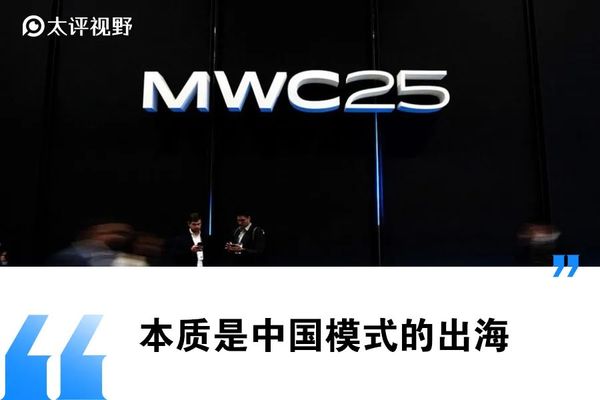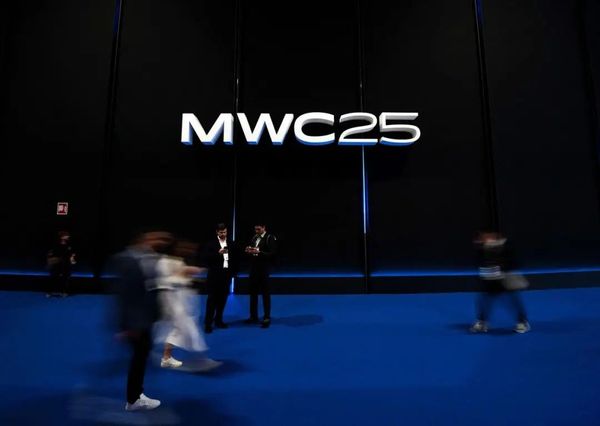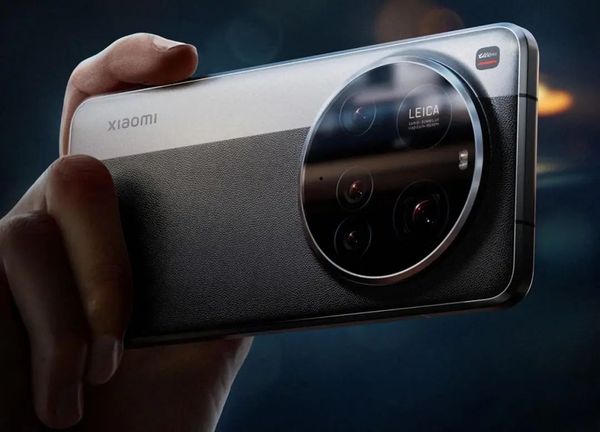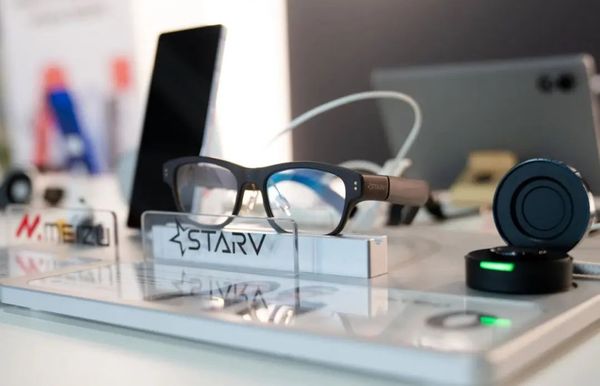Chinese Smartphone Makers Launch a "Second" Wave of Overseas Expansion, What's Different This Time? | MWC Insights
Pacific Technology
2025-03-05 16:08:47


Author: Liu Fan
Author: Liu Fan
Editor: Lin Jiongjia
Every March, the MWC (Mobile World Congress) held in Barcelona is a crucial stop for domestic brands venturing overseas.Every March, the MWC (Mobile World Congress) held in Barcelona is a crucial stop for domestic brands venturing overseas.
Due to the global craze for generative AI, last year's MWC saw AI as the sole protagonist, attracting the most attention. This year, products related to AI remain one of the most important highlights of the MWC.Due to the global craze for generative AI, last year's MWC saw AI as the sole protagonist, attracting the most attention. This year, products related to AI remain one of the most important highlights of the MWC.
However, beyond the products, the overseas strategies of domestic smartphone manufacturers are also undergoing significant changes.However, beyond the products, the overseas strategies of domestic smartphone manufacturers are also undergoing significant changes.
During this year's MWC, multiple smartphone manufacturers such as Xiaomi, Nubia, and realme launched several new products aimed at overseas markets. Xiaomi also announced a timeline for its car exports, while Huawei, Meizu, and others, after being absent from the overseas smartphone market for many years, are setting sail again.During this year's MWC, multiple smartphone manufacturers such as Xiaomi, Nubia, and realme launched several new products aimed at overseas markets. Xiaomi also announced a timeline for its car exports, while Huawei, Meizu, and others, after being absent from the overseas smartphone market for many years, are setting sail again.
In 2025, domestic smartphone manufacturers are initiating a "second wave" of overseas expansion.In 2025, domestic smartphone manufacturers are initiating a "second wave" of overseas expansion.
 In the first three quarters of 2024, Xiaomi's overseas market revenue reached 116.1 billion yuan, a year-on-year increase of about 30%, accounting for 45.2% of Xiaomi's total revenue during the same period. Clearly, the overseas market is undoubtedly one of Xiaomi's most important growth engines.In the first three quarters of 2024, Xiaomi's overseas market revenue reached 116.1 billion yuan, a year-on-year increase of about 30%, accounting for 45.2% of Xiaomi's total revenue during the same period. Clearly, the overseas market is undoubtedly one of Xiaomi's most important growth engines.
At this year's MWC, Xiaomi showcased dozens of new products including smartphones, cars, and smart home devices. Lu Weibing, a partner and president of the Xiaomi Group, announced several new overseas plans and goals.
Lu Weibing stated, "We are currently about 30 million units away from reaching 200 million. Our goal is to reach this milestone by 2026, at the latest by 2027, within the next 2-3 years." He believes that by then, the global market will form two distinct groups: one with three companies in the 200 million sales category—Xiaomi, Apple, and Samsung—and another with 100 million sales, which may include two or three companies. Below that, there will be a tier around 50 million units, creating a clear hierarchy among manufacturers based on sales volume.
In addition to increasing sales, Xiaomi is also aiming to capture the high-end market. In fact, although it has been expanding overseas for many years, it wasn't until 2023 that Xiaomi first entered the ultra-high-end market above $1,000. In June of that year, the Xiaomi 13 Ultra was launched in Europe, marking the first time an Ultra model was introduced to the overseas market.
Lu Weibing said that in the overseas market, Xiaomi's most important goal now is to solidify its position in the $600-$1,000 price range (approximately RMB 4,730-7,280). For the ultra-high-end market above $1,000, Xiaomi will primarily rely on the recently released Xiaomi 15 Ultra.
In the first three quarters of 2024, Xiaomi's overseas market revenue reached 116.1 billion yuan, a year-on-year increase of about 30%, accounting for 45.2% of Xiaomi's total revenue during the same period. Clearly, the overseas market is undoubtedly one of Xiaomi's most important growth engines.In the first three quarters of 2024, Xiaomi's overseas market revenue reached 116.1 billion yuan, a year-on-year increase of about 30%, accounting for 45.2% of Xiaomi's total revenue during the same period. Clearly, the overseas market is undoubtedly one of Xiaomi's most important growth engines.
At this year's MWC, Xiaomi showcased dozens of new products including smartphones, cars, and smart home devices. Lu Weibing, a partner and president of the Xiaomi Group, announced several new overseas plans and goals.
Lu Weibing stated, "We are currently about 30 million units away from reaching 200 million. Our goal is to reach this milestone by 2026, at the latest by 2027, within the next 2-3 years." He believes that by then, the global market will form two distinct groups: one with three companies in the 200 million sales category—Xiaomi, Apple, and Samsung—and another with 100 million sales, which may include two or three companies. Below that, there will be a tier around 50 million units, creating a clear hierarchy among manufacturers based on sales volume.
In addition to increasing sales, Xiaomi is also aiming to capture the high-end market. In fact, although it has been expanding overseas for many years, it wasn't until 2023 that Xiaomi first entered the ultra-high-end market above $1,000. In June of that year, the Xiaomi 13 Ultra was launched in Europe, marking the first time an Ultra model was introduced to the overseas market.
Lu Weibing said that in the overseas market, Xiaomi's most important goal now is to solidify its position in the $600-$1,000 price range (approximately RMB 4,730-7,280). For the ultra-high-end market above $1,000, Xiaomi will primarily rely on the recently released Xiaomi 15 Ultra.
 It is worth noting that the starting price of the Xiaomi 15 Ultra in Europe is 1,499 euros (approximately 11,453 RMB), which is nearly 5,000 RMB higher than its domestic market price and also exceeds the starting price of the Apple iPhone 16 Pro Max in Europe.
Regarding the significant price difference between domestic and international markets, Lei Jun stated: "There are differences in tariffs and channel costs, but overall, it is priced higher than the iPhone 16 Pro Max in Europe, I believe this reflects Xiaomi's technological confidence and strength."
The market performance of the Xiaomi 15 Ultra seems to prove that Xiaomi's strategy is beginning to pay off. On March 3rd, Lei Jun announced on Weibo that the initial sales volume of the Xiaomi 15 Ultra in the Chinese market had increased by more than 50% compared to the same period for the previous generation, while in overseas markets, the pre-order volume of the model had seen a year-on-year growth of over 100%.The market performance of the Xiaomi 15 Ultra seems to prove that Xiaomi's strategy is starting to work. On March 3, Lei Jun posted on Weibo that the initial sales volume of the Xiaomi 15 Ultra in the Chinese market exceeded that of its predecessor by more than 50% during the same period, and in the overseas market, the pre-order volume of this model achieved a year-on-year growth of over 100%.
"Pushing our development in the high-end market is more important than ever," Lei Jun said at the MWC press conference."Pushing our development in the high-end market is more important than ever," Lei Jun said at the MWC press conference.
It is worth mentioning that the newly launched Xiaomi SU7 Ultra, with approximately 20,000 pre-orders, was also showcased at this year's MWC. As a result, many people are also very concerned about the progress of Xiaomi's automotive overseas expansion.It is worth mentioning that the newly launched Xiaomi SU7 Ultra, with approximately 20,000 pre-orders, was also showcased at this year's MWC. As a result, many people are also very concerned about the progress of Xiaomi's automotive overseas expansion.
In response to this, Lei Jun also provided a rough timeline: "After this MWC, I will visit several European countries to assess the market and see how our global overseas data actually looks. One of my goals is to officially go abroad in 2027."In response to this, Lei Jun also provided a rough timeline: "After this MWC, I will visit several European countries to assess the market and see how our global overseas data actually looks. One of my goals is to officially go abroad in 2027."
It is worth noting that the starting price of the Xiaomi 15 Ultra in Europe is 1,499 euros (approximately 11,453 RMB), which is nearly 5,000 RMB higher than its domestic market price and also exceeds the starting price of the Apple iPhone 16 Pro Max in Europe.
Regarding the significant price difference between domestic and international markets, Lei Jun stated: "There are differences in tariffs and channel costs, but overall, it is priced higher than the iPhone 16 Pro Max in Europe, I believe this reflects Xiaomi's technological confidence and strength."
The market performance of the Xiaomi 15 Ultra seems to prove that Xiaomi's strategy is beginning to pay off. On March 3rd, Lei Jun announced on Weibo that the initial sales volume of the Xiaomi 15 Ultra in the Chinese market had increased by more than 50% compared to the same period for the previous generation, while in overseas markets, the pre-order volume of the model had seen a year-on-year growth of over 100%.The market performance of the Xiaomi 15 Ultra seems to prove that Xiaomi's strategy is starting to work. On March 3, Lei Jun posted on Weibo that the initial sales volume of the Xiaomi 15 Ultra in the Chinese market exceeded that of its predecessor by more than 50% during the same period, and in the overseas market, the pre-order volume of this model achieved a year-on-year growth of over 100%.
"Pushing our development in the high-end market is more important than ever," Lei Jun said at the MWC press conference."Pushing our development in the high-end market is more important than ever," Lei Jun said at the MWC press conference.
It is worth mentioning that the newly launched Xiaomi SU7 Ultra, with approximately 20,000 pre-orders, was also showcased at this year's MWC. As a result, many people are also very concerned about the progress of Xiaomi's automotive overseas expansion.It is worth mentioning that the newly launched Xiaomi SU7 Ultra, with approximately 20,000 pre-orders, was also showcased at this year's MWC. As a result, many people are also very concerned about the progress of Xiaomi's automotive overseas expansion.
In response to this, Lei Jun also provided a rough timeline: "After this MWC, I will visit several European countries to assess the market and see how our global overseas data actually looks. One of my goals is to officially go abroad in 2027."In response to this, Lei Jun also provided a rough timeline: "After this MWC, I will visit several European countries to assess the market and see how our global overseas data actually looks. One of my goals is to officially go abroad in 2027."
 In Lu Weibing's view, the primary goal of Xiaomi's automotive business in recent years is still to establish a solid foothold in the domestic market and lay a strong foundation.In Lu Weibing's view, the primary goal of Xiaomi's automotive business in recent years is still to establish a solid foothold in the domestic market and lay a strong foundation.
To support the target of 200 million smartphone sales and to prepare for the future overseas expansion of its automotive business, Xiaomi aims to establish 10,000 Xiaomi stores abroad between 2025 and 2029. "If there are 10,000 Xiaomi stores, it would be like building a highway to the world," said Lu Weibing.To support the target of 200 million smartphone sales and to prepare for the future overseas expansion of its automotive business, Xiaomi aims to establish 10,000 Xiaomi stores abroad between 2025 and 2029. "If there are 10,000 Xiaomi stores, it would be like building a highway to the world," said Lu Weibing.
Building local stores overseas is equivalent to establishing a global distribution system for Xiaomi, where other Xiaomi products can also be sold in the future, just like the Xiaomi stores in China.Building local stores overseas is equivalent to establishing a global distribution system for Xiaomi, where other Xiaomi products can also be sold in the future, just like the Xiaomi stores in China.
Furthermore, Lu Weibing also mentioned that starting from 2025, the export of Xiaomi's large home appliances will also be on the agenda.Furthermore, Lu Weibing also mentioned that starting from 2025, the export of Xiaomi's large home appliances will also be on the agenda.
Although Xiaomi's automotive business will not officially go overseas until 2027, from high-end smartphones to large home appliances, and then to the early establishment of a local distribution system for cars, it is clear that 2025 will be a key node for Xiaomi's "second" overseas push.Although Xiaomi's automotive business will not officially go overseas until 2027, from high-end smartphones to large home appliances, and then to the early establishment of a local distribution system for cars, it is clear that 2025 will be a key node for Xiaomi's "second" overseas push.
In Lu Weibing's view, the primary goal of Xiaomi's automotive business in recent years is still to establish a solid foothold in the domestic market and lay a strong foundation.In Lu Weibing's view, the primary goal of Xiaomi's automotive business in recent years is still to establish a solid foothold in the domestic market and lay a strong foundation.
To support the target of 200 million smartphone sales and to prepare for the future overseas expansion of its automotive business, Xiaomi aims to establish 10,000 Xiaomi stores abroad between 2025 and 2029. "If there are 10,000 Xiaomi stores, it would be like building a highway to the world," said Lu Weibing.To support the target of 200 million smartphone sales and to prepare for the future overseas expansion of its automotive business, Xiaomi aims to establish 10,000 Xiaomi stores abroad between 2025 and 2029. "If there are 10,000 Xiaomi stores, it would be like building a highway to the world," said Lu Weibing.
Building local stores overseas is equivalent to establishing a global distribution system for Xiaomi, where other Xiaomi products can also be sold in the future, just like the Xiaomi stores in China.Building local stores overseas is equivalent to establishing a global distribution system for Xiaomi, where other Xiaomi products can also be sold in the future, just like the Xiaomi stores in China.
Furthermore, Lu Weibing also mentioned that starting from 2025, the export of Xiaomi's large home appliances will also be on the agenda.Furthermore, Lu Weibing also mentioned that starting from 2025, the export of Xiaomi's large home appliances will also be on the agenda.
Although Xiaomi's automotive business will not officially go overseas until 2027, from high-end smartphones to large home appliances, and then to the early establishment of a local distribution system for cars, it is clear that 2025 will be a key node for Xiaomi's "second" overseas push.Although Xiaomi's automotive business will not officially go overseas until 2027, from high-end smartphones to large home appliances, and then to the early establishment of a local distribution system for cars, it is clear that 2025 will be a key node for Xiaomi's "second" overseas push.
 Over the past few years, due to external restrictions, Huawei has faced extremely harsh challenges in the overseas smartphone market.
According to Canalys data, in 2019, Huawei (including Honor) shipped about 100 million smartphones in overseas markets, accounting for approximately 40% of its global total shipments. However, starting from 2020, with limitations on chip supplies, Huawei was forced to retreat from the overseas market.
By last year, according to a report by Wall Street News, Huawei's overseas sales had dropped to around 9.8 million units, less than one-tenth of its peak period.
In 2023, the Huawei Mate60 series, equipped with Kirin chips, made a comeback to the smartphone market; in 2024, with a 16% market share, Huawei became the second-largest player in China's smartphone market. Having regained its footing, Huawei is also accelerating its return to the overseas market.
Over the past few years, due to external restrictions, Huawei has faced extremely harsh challenges in the overseas smartphone market.
According to Canalys data, in 2019, Huawei (including Honor) shipped about 100 million smartphones in overseas markets, accounting for approximately 40% of its global total shipments. However, starting from 2020, with limitations on chip supplies, Huawei was forced to retreat from the overseas market.
By last year, according to a report by Wall Street News, Huawei's overseas sales had dropped to around 9.8 million units, less than one-tenth of its peak period.
In 2023, the Huawei Mate60 series, equipped with Kirin chips, made a comeback to the smartphone market; in 2024, with a 16% market share, Huawei became the second-largest player in China's smartphone market. Having regained its footing, Huawei is also accelerating its return to the overseas market.
 In January of this year, according to media reports, Huawei is aiming for a global comeback, increasing the number of markets selling its high-performance chip phones to about 60. It has already set up large billboards in international cities such as Paris, Singapore, Dubai, Milan, Munich, Istanbul, Warsaw, and Mexico City, loudly announcing its return to these local markets.
At this year's MWC, Huawei is accelerating its steps to return to overseas markets, bringing a series of new products aimed at overseas customers, including the Mate70 series, Mate XT, MatePad Pro, as well as the Huawei WATCH GT 5 series and WATCH D2.
Despite being away from the overseas market for several years, Huawei still enjoys a high level of brand recognition globally, thanks to its past market position. According to media reports, King Felipe VI of Spain visited the Huawei booth and experienced the Huawei Mate XT tri-fold phone.
However, Huawei's return to the overseas market still faces many challenges. Due to U.S. sanctions, Huawei cannot pre-install Google's suite of apps (such as YouTube, Google Play, etc.), which naturally poses a certain barrier to overseas users.
Moreover, the production capacity of the Huawei Mate 70 series is also a major issue. Although it has been on the market in China for more than three months, models such as the Mate 70 Pro+ still require reservation for purchase on Huawei's official online store.
In fact, Meizu is going overseas again after many years. However, Meizu's return to the international market is not due to external restrictions but rather internal changes. In 2022, Meizu was acquired by Star Era, a subsidiary of Geely Group, and in 2023, it merged with the latter to form the Star Era Meizu Group. It was only in 2024 that Star Era Meizu began to go overseas again.
At this year's MWC, Meizu launched three new phones: Note 22, mblu 22, and mblu 22 Pro, along with the StarV smart glasses series. The company also showcased three core segments based on Flyme AIOS: smart glasses, smartphones, and smart car scenarios, as well as cross-device collaboration capabilities.
In January of this year, according to media reports, Huawei is aiming for a global comeback, increasing the number of markets selling its high-performance chip phones to about 60. It has already set up large billboards in international cities such as Paris, Singapore, Dubai, Milan, Munich, Istanbul, Warsaw, and Mexico City, loudly announcing its return to these local markets.
At this year's MWC, Huawei is accelerating its steps to return to overseas markets, bringing a series of new products aimed at overseas customers, including the Mate70 series, Mate XT, MatePad Pro, as well as the Huawei WATCH GT 5 series and WATCH D2.
Despite being away from the overseas market for several years, Huawei still enjoys a high level of brand recognition globally, thanks to its past market position. According to media reports, King Felipe VI of Spain visited the Huawei booth and experienced the Huawei Mate XT tri-fold phone.
However, Huawei's return to the overseas market still faces many challenges. Due to U.S. sanctions, Huawei cannot pre-install Google's suite of apps (such as YouTube, Google Play, etc.), which naturally poses a certain barrier to overseas users.
Moreover, the production capacity of the Huawei Mate 70 series is also a major issue. Although it has been on the market in China for more than three months, models such as the Mate 70 Pro+ still require reservation for purchase on Huawei's official online store.
In fact, Meizu is going overseas again after many years. However, Meizu's return to the international market is not due to external restrictions but rather internal changes. In 2022, Meizu was acquired by Star Era, a subsidiary of Geely Group, and in 2023, it merged with the latter to form the Star Era Meizu Group. It was only in 2024 that Star Era Meizu began to go overseas again.
At this year's MWC, Meizu launched three new phones: Note 22, mblu 22, and mblu 22 Pro, along with the StarV smart glasses series. The company also showcased three core segments based on Flyme AIOS: smart glasses, smartphones, and smart car scenarios, as well as cross-device collaboration capabilities.
 "mblu" is a sub-brand of Meizu, known as "Meilan," targeting the mid-to-low-end market below 2000 yuan. The configurations of the three new phones largely align with this mid-to-low-end positioning. However, Meilan had been on hiatus for many years before this, and its return to the overseas market will likely take some time to re-establish the brand."mblu" is a sub-brand of Meizu, known as "Meilan," targeting the mid-to-low-end market below 2000 yuan. The configurations of the three new phones largely align with this mid-to-low-end positioning. However, Meilan had been on hiatus for many years before this, and its return to the overseas market will likely take some time to re-establish the brand.
At MWC, Xingji Meizu stated that globalization and the "All in AI" strategy are at the core of the company's strategy. Starting from 2025, it plans to accelerate expansion into overseas markets and increase investment in these areas.At MWC, Xingji Meizu stated that globalization and the "All in AI" strategy are at the core of the company's strategy. Starting from 2025, it plans to accelerate expansion into overseas markets and increase investment in these areas.
Honor, during MWC, launched the Alpha Strategy (HONOR ALPHA PLAN), announcing a transition from a smartphone manufacturer to a globally leading AI terminal ecosystem company. A key part of this initiative is that Honor will invest over $100 billion over the next five years to build an open, co-created, and shared AI terminal ecosystem with global partners.HONOR launched the ALPHA PLAN (HONOR ALPHA PLAN) during MWC, announcing its transformation from a smartphone manufacturer to a globally leading AI terminal ecosystem company. One of the key initiatives is that HONOR will invest over 10 billion US dollars in the next five years to build an open, co-creative, and shared AI terminal ecosystem with global partners.
"mblu" is a sub-brand of Meizu, known as "Meilan," targeting the mid-to-low-end market below 2000 yuan. The configurations of the three new phones largely align with this mid-to-low-end positioning. However, Meilan had been on hiatus for many years before this, and its return to the overseas market will likely take some time to re-establish the brand."mblu" is a sub-brand of Meizu, known as "Meilan," targeting the mid-to-low-end market below 2000 yuan. The configurations of the three new phones largely align with this mid-to-low-end positioning. However, Meilan had been on hiatus for many years before this, and its return to the overseas market will likely take some time to re-establish the brand.
At MWC, Xingji Meizu stated that globalization and the "All in AI" strategy are at the core of the company's strategy. Starting from 2025, it plans to accelerate expansion into overseas markets and increase investment in these areas.At MWC, Xingji Meizu stated that globalization and the "All in AI" strategy are at the core of the company's strategy. Starting from 2025, it plans to accelerate expansion into overseas markets and increase investment in these areas.
Honor, during MWC, launched the Alpha Strategy (HONOR ALPHA PLAN), announcing a transition from a smartphone manufacturer to a globally leading AI terminal ecosystem company. A key part of this initiative is that Honor will invest over $100 billion over the next five years to build an open, co-created, and shared AI terminal ecosystem with global partners.HONOR launched the ALPHA PLAN (HONOR ALPHA PLAN) during MWC, announcing its transformation from a smartphone manufacturer to a globally leading AI terminal ecosystem company. One of the key initiatives is that HONOR will invest over 10 billion US dollars in the next five years to build an open, co-creative, and shared AI terminal ecosystem with global partners.
 At MWC, Lu Weibing summarized the journey of Chinese companies going global as follows: Over the past 30 years, Chinese companies have gone through several stages in their overseas expansion, from exporting products, to building brands, and then to exporting business models.At MWC, Lu Weibing summarized the journey of Chinese companies going global as follows: Over the past 30 years, Chinese companies have gone through several stages in their overseas expansion, from exporting products, to building brands, and then to exporting business models.
The first stage was mainly about OEM (Original Equipment Manufacturer), where brand and industrial added value were relatively low; the second stage saw an increase in brand added value, but it required higher capabilities from manufacturers, such as establishing their own brands, channels, and factories overseas; the third stage not only involves products and brands, but also requires brands to clearly define how and through what channels they should deliver to users.The first stage was mainly about OEM (Original Equipment Manufacturer), where brand and industrial added value were relatively low; the second stage saw an increase in brand added value, but it required higher capabilities from manufacturers, such as establishing their own brands, channels, and factories overseas; the third stage not only involves products and brands, but also requires brands to clearly define how and through what channels they should deliver to users.
In Lu Weibing's view, entering the third phase, Xiaomi needs to bring the domestically explored new retail model overseas. "Domestically, our greatest achievement has been solving the cross-category issue, building a business model centered around smartphones or 3C products. The next step is to use this logic to provide service support overseas," he said.
Indeed, this logic also applies to other Chinese manufacturers. Perhaps we can look forward to more and more Chinese brands, with better products and more comprehensive overseas strategies, becoming world-class brands.
At MWC, Lu Weibing summarized the journey of Chinese companies going global as follows: Over the past 30 years, Chinese companies have gone through several stages in their overseas expansion, from exporting products, to building brands, and then to exporting business models.At MWC, Lu Weibing summarized the journey of Chinese companies going global as follows: Over the past 30 years, Chinese companies have gone through several stages in their overseas expansion, from exporting products, to building brands, and then to exporting business models.
The first stage was mainly about OEM (Original Equipment Manufacturer), where brand and industrial added value were relatively low; the second stage saw an increase in brand added value, but it required higher capabilities from manufacturers, such as establishing their own brands, channels, and factories overseas; the third stage not only involves products and brands, but also requires brands to clearly define how and through what channels they should deliver to users.The first stage was mainly about OEM (Original Equipment Manufacturer), where brand and industrial added value were relatively low; the second stage saw an increase in brand added value, but it required higher capabilities from manufacturers, such as establishing their own brands, channels, and factories overseas; the third stage not only involves products and brands, but also requires brands to clearly define how and through what channels they should deliver to users.
In Lu Weibing's view, entering the third phase, Xiaomi needs to bring the domestically explored new retail model overseas. "Domestically, our greatest achievement has been solving the cross-category issue, building a business model centered around smartphones or 3C products. The next step is to use this logic to provide service support overseas," he said.
Indeed, this logic also applies to other Chinese manufacturers. Perhaps we can look forward to more and more Chinese brands, with better products and more comprehensive overseas strategies, becoming world-class brands.
【Copyright and Disclaimer】The above information is collected and organized by PlastMatch. The copyright belongs to the original author. This article is reprinted for the purpose of providing more information, and it does not imply that PlastMatch endorses the views expressed in the article or guarantees its accuracy. If there are any errors in the source attribution or if your legitimate rights have been infringed, please contact us, and we will promptly correct or remove the content. If other media, websites, or individuals use the aforementioned content, they must clearly indicate the original source and origin of the work and assume legal responsibility on their own.






























